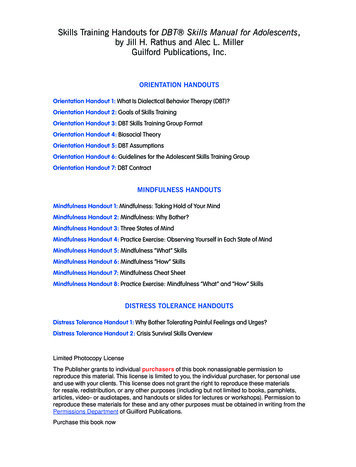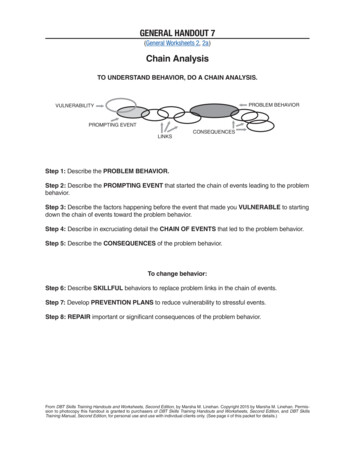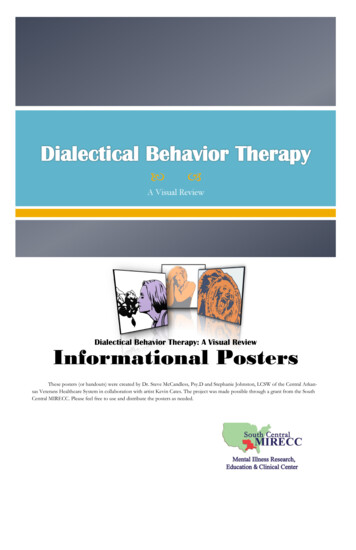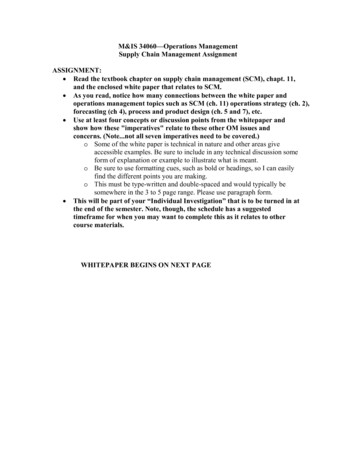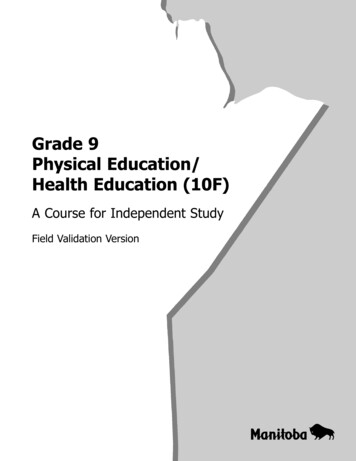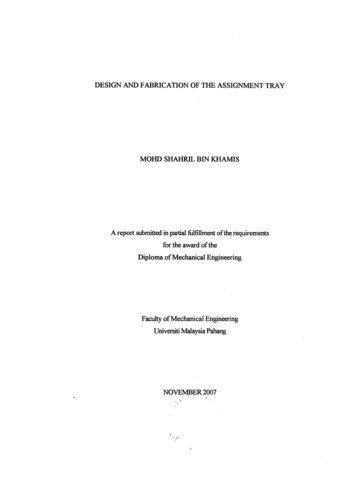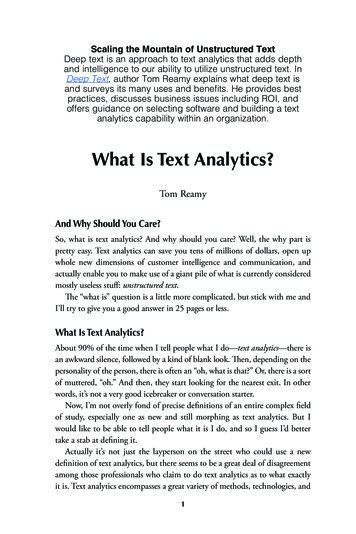
Transcription
DBT Assignment Workbook50 Dialec7cal Behavior Therapy Ac7vi7esBetween Sessions ResourcesNorwalk, CT, USA
DBT Assignment Workbookby Elyse Pipitone, LCSW, and Angela M. Doel, MSCover and Interior Design by Mike Canavan 2020 Between Sessions ResourcesPermission is granted for the purchaser to copy these worksheets for personal or professionaluse, but not for resale. All other rights are reserved.Disclaimer: This book is intended to be used as an adjunct to psychotherapy. If you areexperiencing serious symptoms or problems in your life, seek the help of anexperienced mental health professional.ISBN: 978-1-947009-08-0Published byBetween Sessions Resources304 Main AvenueSuite 333Norwalk, CT 06851About the AuthorsElyse Pipitone, LCSW, is a writer, editor, and clinical social worker. She has worked withpopula7ons including low-income families at risk of homelessness and individuals facing opiateaddic7on. She has served as a volunteer career coach to members of the Na7onal Associa7on ofSocial Workers’ MassachuseXs chapter since 2011. Ms. Pipitone holds a bachelor’s degree fromNortheastern University and an MSW from the Simmons University School of Social Work. She isa licensed clinical social worker.Angela M. Doel, MS, is a writer and director of opera7ons at Between Sessions Resources. Shehas served in various clinical supervisory posi7ons and worked as a family therapist. Ms. Doelholds a bachelor’s degree from the University of Toledo and earned her MS in CounselingPsychology at the University of Pennsylvania. She holds an advanced cer7ficate in nutri7onalcounseling, and her areas of specializa7on are health educa7on and ea7ng disorders.About the SeriesThe DBT Assignment Workbook is part of a series of workbooks designed to give therapists andtheir clients easy access to prac7cal evidence-based psychotherapy tools. Each workbookrepresents a complete treatment program.
TABLE OF CONTENTSiIntroduc7onSec6on 1. MINDFULNESS TECHNIQUES1Mindful Medita7on 1014Focusing on a Single Moment6Increasing Your Awareness of Physical Sensa7ons9Using Visualiza7on to Observe Your Thoughts and Feelings without Judgment12Using Beginner’s Mind to Decrease Judgments and Manage Reac7ons16Performing Tasks with Inten7on19Wise Mind and One-Mindfully24Dealing with Upse ng Memories Through Mindfulness26Giving Up Judging People Nega7vely29Developing Self-CompassionSec6on 2. DISTRESS TOLERANCE35Crea7ng a BeXer Day38Using Distrac7on as a Distress Tolerance Skill42Visualizing a Safe Place44Rehearsing Values-Based Behavior49Pausing During a Distressing Situa7on: The REST Technique53Prac7cing Radical Acceptance59Using Coping Thoughts63Measuring the Intensity of Your Emo7on Against the Level of Threat67Using a Pros and Cons List to Iden7fy the Consequences of Your Urges72Riding the Wave of Your Urges75Using Your Senses to Get GroundedSec6on 3. EMOTION REGULATION SKILLS79Observing Your Emo7ons without Judgment83Observing and Accep7ng Your Emo7ons87Iden7fying Barriers to Healthy Emo7ons and Behaviors91Improving Your Emo7ons by Improving Your Health95Improving Your Healthy Sleeping Habits98Seeing the Big Picture100 Problem Solving for Healthier Emo7onal Responses104 Building Posi7ve Emo7ons109 Managing Catastrophic Thinking114 Increasing Your Sense of Control121 Iden7fying the Physical Signs of Your Emo7ons125 Managing Urges by Burning Bridges and Building New Ones128 Using Opposite Ac7on to Deal with Difficult Emo7ons
Sec6on 4. INTERPERSONAL EFFECTIVENESS SKILLS133 Interpre7ng Body Language138 Iden7fying Rela7onships That Reflect Your Values142 Exercising Your Rights to Your Needs and Feelings146 Communica7ng Your Wants and Needs to Others150 Improving Your Listening Skills154 Improving Your Ability to Say No159 Iden7fying People Who Are Trustworthy to Give You Support162 Seeing Someone Else’s Perspec7ve166 Using “I” Statements to Communicate Effec7vely169 Are You Difficult to Get Along With?173 Rely on Your Problem-Solving Ability Even When You Feel Hopeless179 Developing Healthy Personal Boundaries183 I Feel Disrespected in My Rela7onships187 Making a Simple Request191 Using the Repeat Technique to Make Your Communica7on More Effec7ve195 Loving Kindness Medita7on
INTRODUCTIONWhen Dialec7cal Behavior Therapy (DBT) was developed in the 1970s, it was created to treatadults who self-harm, including those struggling with chronic suicidal thinking and behavior.Ini7ally, women with borderline personality disorder were treated. Over the years, DBT hasproved its effec7veness in trea7ng individuals with anxiety, substance abuse problems, PTSD,and other disorders.Today, DBT is widely used by therapists to help clients – including those without a diagnosis –who are seeking to manage their overwhelming emo7ons in healthier ways.Some Background on DBTDBT is derived from Cogni7ve Behavioral Therapy (CBT), which focuses on helping peopleunderstand how their thoughts impact their feelings and behaviors. The main divergingprinciple in DBT is the word “dialec7cal,” which describes the tension between two opposingforces that are both true. In the case of DBT, “dialec7cal” refers to the concepts of acceptanceand change. Clients focus on changing what is possible, accep7ng what cannot be changed, and– with therapeu7c guidance – determining which of those two op7ons is healthiest.In DBT, clients learn techniques to accept their intense emo7ons and thoughts in the presentmoment, without taking ac7on to avoid or change them. They discover that their harmfulbehavior is their effort to cope with their overwhelming feelings in that moment. At the same7me, clients work on adop7ng healthier reac7ons to distressing situa7ons, ul7mately makingbehavioral changes toward building a meaningful life.DBT uses four basic skills – mindfulness, distress tolerance, emo7on regula7on, andinterpersonal effec7veness – to help clients navigate their environment and their rela7onships.1. Mindfulness – refers to an awareness of thoughts, feelings, behaviors, and behavioral urges.By learning mindfulness, clients are empowered to be in charge of themselves in different ways.2. Distress Tolerance – addresses the tendency of some clients to experience nega7ve emo7onsas overwhelming and unbearable. People with low tolerance for distress become overwhelmedwhen faced with even low levels of stress, ooen reac7ng in unhealthy ways. Clients learn therewill be 7mes when pain is unavoidable, and the healthiest way of coping involves accep7ng andtolera7ng distress.3. Emo6on Regula6on – teaches clients how to manage distressing and overwhelmingemo7ons while increasing their posi7ve experiences through: Understanding emo7ons Reducing emo7onal vulnerability Decreasing emo7onal sufferingClients learn that distressing emo7ons are not bad or something to be avoided. All emo7ons area normal part of life, and there are ways to acknowledge and let go of emo7ons without beingcontrolled by them.iq
4. Interpersonal Effec6veness – refers to how people interact with the people around them andwithin rela7onships. Clients learn strategies to ask for what they need, asser7vely say ‘no,’ andcope with interpersonal conflict.Using This Workbook in General Prac6ceDBT techniques are useful in addressing a wide range of concerns and disorders and cancomplement a variety of therapeu7c approaches. Therefore, the DBT Assignment Workbookwas wriXen to support therapists who work in a general prac7ce, as well as those whospecialize. Furthermore, instead of limi7ng its scope to clients who present with self-injury andsuicidality, this DBT workbook can benefit anyone seeking to replace unhealthy behaviors withhealthy coping skills.This workbook offers 50 worksheets that will help clients learn strategies to manage theiremo7ons in construc7ve ways, instead of turning to overea7ng, alcohol abuse, prac7cing unsafesex, overspending, lashing out in anger, or other harmful behaviors. The worksheetscomplement the content you and your clients cover during your appointment, by providinghomework for them to do between sessions.This workbook is divided into techniques covering each of the four DBT skills: mindfulness,distress tolerance, emo7on regula7on, and interpersonal effec7veness. Each worksheet iswriXen specifically for clients, in a manner that is prac7cal, user-friendly, and easy tounderstand. While no single worksheet is effec7ve for everyone, we are confident each clientwill discover techniques that inspire change.The Importance of DBT HomeworkEvidence-based therapies like DBT teach clients new cogni7ve, emo7onal, behavioral, and socialskills to combat paXerns of nega7ve thinking and behavior. For these new skills to be mosteffec7ve, clients need to prac7ce them regularly – between therapy sessions. Using homeworkassignments, clients can rehearse new coping strategies and challenge harmful beliefs,strengthening the insights and inten7ons that surface during a therapy session.Numerous research studies suggest that homework enhances the effec7veness of therapysessions, and that clients who complete homework assignments on a consistent basis tend tohave beXer outcomes. In addi7on to giving the therapy context and focus, homework providesconcrete feedback for the therapist about a client’s progress. For instance, when there areissues with homework compliance, therapists can iden7fy obstacles and challenges to theclient’s goal achievement.qii
Guidelines for Using DBT Homework AssignmentsAs with any therapeu7c technique, homework is most effec7ve when used in conjunc7on with atreatment plan tailored to each client’s unique needs and learning style. The followingguidelines will help you integrate DBT homework assignments into your prac7ce.1. Early in the treatment process, introduce the importance of using homework as a tool thatcan help your client make progress. If you are formula7ng a treatment plan, therapyassignments should be included as part of that plan. If either of you prefers not to use the term“homework,” try “Ac7on Plan,” “Wellness Prac7ce Sheet,” or another agreed-upon name.2. Explain the homework assignment process, including how the worksheets will be selectedand assigned, and how they relate to a specific goal or problem the client is facing. Explain whyeach assigned worksheet is beneficial to the client, and how to use it in daily life. It can behelpful to rehearse the exercises together in-session, and to illustrate how the skills learned canimprove the client’s well-being and rela7onships.3. Match the homework assignments to the client’s learning style, taking into account how theylearn and processes informa7on. Addi7onally, the client’s personality and history can play a rolein the assignment selec7on; for example, a client may balk at using techniques involvingmindfulness and visualiza7on. You may find that while one client responds to one type ofassignment, another may not benefit at all.4. Request that clients commit to doing therapy homework and to comple7ng assignments. Insome cases, therapists may ask clients to sign a behavior contract where clients agree tocomplete homework in order to meet their specified goals and objec7ves. Therapists shouldalso discuss any mo7va7onal issues surrounding the homework and discuss ideas to eliminateobstacles to comple7on. It may be useful to discuss ways people can mo7vate themselves tochange, including giving themselves small rewards and asking for support from friends or familymembers.5. Ask clients about an7cipated obstacles they may face as they work on therapy assignments.Some might have busy schedules that make it difficult to find 7me to complete the homework.Others may struggle to face their thoughts, emo7ons, and urges without their therapist si ngalongside them. Clients struggling with obstacles or mo7va7on may benefit from remindersabout their assignments, which can be done by text or email.6. Be consistent in the way you assign the homework during a session and how you follow upwith your client in subsequent sessions. Take 7me at the beginning of each session to go overthe previous week’s assignment, and spend a few minutes at the end of each session reviewingthe next worksheet.7. Request feedback on each assignment to determine therapeu7c effec7veness: what theclient learned, what was helpful and not helpful about the exercise, and what was emo7onallydifficult or challenging. This feedback is essen7al when determining future assignments andnext steps.qiii
How to Use this WorkbookThe worksheets in this book are intended to be used as tools to complement the therapeu7capproaches you use with your clients. They are designed to increase clients’ awareness of therela7onship between their emo7ons, thoughts, and physical sensa7ons, and their unhealthyurges and behaviors. The assignments provide steps for clients to manage their distress andoverwhelming emo7ons in healthier ways. However, this workbook is not intended for clientswho are in crisis.You can recommend or purchase this book for your clients, and they can write directly on thepages and bring it to each therapy session for further discussion.This workbook is divided into sec7ons according to the four skills of DBT: mindfulness, distresstolerance, emo7on regula7on, and interpersonal effec7veness. Each worksheet has foursec7ons: Objec7ve, You Should Know, What to Do, and Reflec7ons on This Exercise. TheObjec6ve states what the client should expect to have accomplished upon comple7on of theworksheet. You Should Know offers background informa7on about the issue(s) being addressedin the worksheet. What to Do features a variety of exercises, including thought-provokingques7ons to answer, charts to track ac7vi7es, and ques7onnaires to complete.In the Reflec6ons sec7on, clients are asked to provide feedback on the worksheet, includingra7ng how much the exercise helped them, and wri7ng what they learned from the exercise.This is perhaps the most important part of the worksheet because it helps you and the clientdetermine any progress or improvement that was made upon comple7on of the assignment.qiv
SECTION 1.MINDFULNESS TECHNIQUES
Mindful Medita7on 101Objec6veTo quiet your mind and body through prac7cing formal and informal mindful medita7on.You Should KnowMindfulness means no7cing what is happening right here and now, without judgment and withacceptance. Even a few minutes of quie7ng the mind and body on a regular basis can reap bigbenefits – less depression, less anxiety, less stress – and improvements in memory andaXen7on. When you are mindful and aware you train your brain to default to a more relaxedstate. This happens only with regular prac7ce. Just as a runner must train to run a marathonwithout proper training, so you need to train to reap the benefits of medita7on. Slow andsteady. One step at a 7me.Some7mes you might want to meditate with music, some7mes without. Search for medita7on,mindfulness, or guided visualiza7on recordings on YouTube. Explore, experiment, and find whatworks best for you.There are two categories of mindfulness medita7on prac7ces: formal and informal. FormalpracCce requires se ng aside a specific 7me each day or twice a day to be mindful, and it canbe done either si ng or walking. Informal pracCce refers to paying mindful, nonjudgmentalaXen7on while doing certain rou7ne daily ac7vi7es such as taking a shower, washing the dishes,making your bed, going for a walk, and so on. Start by choosing one daily ac7vity at a 7me soyou avoid feeling overwhelmed.What to DoIn this exercise, you will start with the formal prac7ce of si ng medita7on. Si ng medita7onrequires se ng aside a specific 7me each day or twice a day, or as ooen as you can, to sitquietly with your eyes closed (or open, gazing steadily downward, if you prefer). Experts ooenrecommend twenty minutes per day, but if that does not work for you, try ten. Or five. Or evenstart with three. You can always build up over 7me, just like marathon runners in training.For your si ng medita7on, find a 7me when you can eliminate all distrac7ons and unplug fromthe world. To start, you might choose to repeat a mantra; that is, a word of your choice, such as“peace,” “calm,” “one,” “love,” or something you can use as your anchor when your mindwanders – which it inevitably will.Avoid worry and self-judgment. Just watch the thoughts floa7ng past you, like clouds in the sky.The mindful moment comes when you noCce your mind wandering. Simply bring your aXen7onback to your anchor. You can also use your breath as an anchor, or any mindful self-compassionphrases. By regularly prac7cing si ng s7ll and simply no7cing the flow of thoughts andsensa7ons without judgment and with acceptance, you will get beXer at no7cing when you are1q
not mindful. Again, that “waking up” moment is a moment of mindfulness, pulling you out ofyour trance and into the present moment.For your informal mindfulness prac7ce, pick one of the ac7vi7es men7oned above (taking ashower, washing the dishes, or going for a walk) and see what it is like to pay full aXen7on towhat is happening right here and now. In the shower, do you feel the water on your body? Is itwarm enough? Do you feel the soap – can you be present throughout the shower? If your mindwanders, bring it back to the sensory experience of being in the shower.This week, schedule at least three or four formal si ng medita7on sessions, and one or twoinformal prac7ces. During each ac7vity, prac7ce being mindful, that is, no7cing how your bodyfeels; no7cing your breath; no7cing any sensory experiences such as what you see, hear, smell,or touch. Write down your experiences and your responses.DateFormal Prac6ceInformal Prac6ceResponseExample:MondaySat for 10 mins. on my couchaHer work - no phone or TV!Focused on breath.Paid aMenCon whilebrushing teeth.Got fidgety but stuck with it,noCced I was fidgeCng but Itried not to judge.Tasted the minty toothpaste.2q
Reflec6ons on This ExerciseWhat was it like to engage in mindfulness prac7ces each day? Did you experience challenges, orwas it easy to fit in the exercises each day? Describe.How helpful was this exercise?(1 not very helpful, 5 moderately helpful, 10 extremely helpful)What did you learn from this exercise?3q
Focusing on a Single MomentObjec6veTo become more mindful of your experiences by focusing on a single moment in 7me.You Should KnowDuring distressing situa7ons, overwhelming emo7ons can make it challenging to focus onanything outside of your pain or discomfort. Your intense thoughts and feelings can lead toharmful urges and impulses, making it nearly impossible to make informed decisions or findhealthy coping strategies.By being in the moment, otherwise known as mindfulness, you focus your aXen7on on only oneminute at a 7me. This enables you to no7ce your feelings without judgment, helping you beXermanage and soothe those emo7ons.What You Should DoWhen you focus on a single moment, you become more mindful of your own sense of 7me. Thefollowing exercise will help you become more mindful of your experiences by focusing on asingle moment in 7me. For this exercise, you will need a stopwatch, the 7mer app on yourphone, or a second hand on your watch.1. Find a quiet, comfortable space to sit where you will not be disturbed or distracted.2. Begin 7ming yourself while si ng quietly – without watching the 7mer.3. When you think one minute has passed, check your 7mer to see how much 7me has actuallyelapsed.Name: Date:How many seconds or minutes were displayed on your 7mer?How many seconds less than, or more than, a minute did you es7mate had passed?Were you surprised at the accuracy or inaccuracy of your percep7on of 7me? Explain.How do you think your percep7on of 7me impacts how you make a decision or react to asitua7on? For example, do you rush to make a decision, or spend your 7me thinking about whatmight happen next? Or, do you delay taking ac7on or planning for a situa7on because youbelieve you have more 7me? Explain.4q
Describe a situa7on where your percep7on of 7me impacted how you reacted to a situa7on.Reflec6ons on This ExerciseHas your awareness of a single moment changed the way you think about 7me?Has your awareness of how you perceive 7me changed the way you might react to a situa7on inthe future?How helpful was this exercise?(1 not very helpful, 5 moderately helpful, 10 extremely helpful)Is there anything in par7cular you learned from this exercise?5q
Increasing Your Awareness of Physical Sensa7onsObjec6veTo become more aware of your physical sensa7ons as your body reacts to overwhelmingemo7ons.You Should KnowOverwhelming emo7ons can cause discomfort in your body, from headaches and diges7veissues to muscle tension. When you are mindful of sensa7ons in your body, you begin to no7cehow your thoughts and emo7ons impact you physically.What to DoThe following medita7on exercise will help you observe your physical sensa7ons withoutjudgment. Please note that it is normal for your aXen7on to wander as you do the exercise. Donot cri7cize yourself; instead, simply no7ce your focus has shioed and gently return youraXen7on to this exercise. Find a quiet, comfortable space to sit where you will not be disturbed or distracted forapproximately 10 minutes. Take several long, slow breaths and close your eyes. Imagine you have a narrow band of white light circling your head like a halo. As you imagine the band of light moving down your body, pay aXen7on to any physicalsensa7ons you experience in that part of the body. As the band of light descends slowly around your head, over your ears, and then over youreyes, nose, and mouth, no7ce any physical sensa7ons, such as scalp 7ngling, muscle tension,or pain. Con7nue to imagine the band of light moving down to other parts of your upper torso, fromyour neck and your shoulders, to your upper back, upper arms, elbows, wrists, hands, andfingers. No7ce any 7ngling, itching, 7ghtness, or pain. Con7nue to imagine the band of light moving down to your lower torso, from your ribs toyour lower back to your stomach. No7ce any 7ngling, itching, 7ghtness, or pain. Now, imagine the band of light moving down to your lower body, including your pelvic area,buXocks, and thighs. No7ce any 7ngling, itching, 7ghtness, or pain.6q
Finally, imagine the band of light moving down to your lower legs, shins, feet, and toes. Again, no7ce any 7ngling, itching, 7ghtness, or pain. Imagine the band of light disappearing into the ground as you take several long, slow breaths.Open your eyes when you are ready.What physical sensa7ons did you no7ce during this exercise? Describe.Were there any sensa7ons that surprised you? Explain.Did it feel comfortable or uncomfortable to focus on your body’s sensa7ons? Explain.What emo7ons or feelings did you no7ce during this exercise? Describe.Reflec6ons on This ExerciseDid your awareness of your physical sensa7ons increase your awareness of distressing orupse ng emo7ons? Explain.7q
Now, try this exercise following a par7cularly upse ng experience. Describe your experience,focusing on your physical sensa7ons.How helpful was this exercise?(1 not very helpful, 5 moderately helpful, 10 extremely helpful)Is there anything in par7cular you learned from this exercise?8q
Using Visualiza7on to Observe Your Thoughts andFeelings without JudgmentObjec6veTo use visualiza7on to observe your thoughts, emo7ons, and physical sensa7ons withoutjudgment.You Should KnowWhen you experience distressing thoughts repeatedly, you can get stuck in that nega7ve space.In addi7on to cri7cizing yourself and your thoughts, you may become judgmental of youroverwhelming emo7ons. When you observe your thoughts and feelings objec7vely, you arebeXer able to determine which thoughts are useful to you and which can lead to harmfulbehaviors.What to DoThe following visualiza7on exercise will help you observe your thoughts and feelings (bothphysical and emo7onal), without judgment, analysis, or rumina7on. The inten7on of thisexercise is not for you to stop thinking – which is impossible to do – but to no7ce your thoughtsas they come and go, without holding on to them.Find a quiet, comfortable space to sit where you will not be disturbed or distracted and set your7mer for five minutes. Take several long, slow breaths and close your eyes. Imagine yourself in a calm, peaceful se ng, such as at the beach or in the forest. Picture your thoughts as leaves floa7ng down a stream, as clouds drioing by, or as shells on abeach that get washed away by waves. You can also create your own scenario where youwatch your thoughts disappear as new ones arise. Observe your thoughts as they come and go, one at a 7me, without judgment. If yourthoughts come very quickly, do your best to no7ce each one and let them go. Do not try to stop your thoughts. If you discover you are cri7cizing yourself for what you are thinking, it might be helpful to say,“This is just a thought. I am not my thoughts.” Or, “Thoughts are not facts.” You can also juststate, “I am having a thought about X.” Observe any emo7ons or physical sensa7ons that arise. Take several long, slow breaths and open your eyes.9q
Describe what it was like to no7ce your thoughts without judging them. Was it easy or difficult?What emo7ons did you no7ce as you observed your thoughts?What physical sensa7ons did you no7ce as you observed your thoughts?Describe any urges or impulses that arose as you observed your thoughts.Reflec6ons on This ExerciseHow did this exercise change the way you acknowledge your thoughts, including any selfjudgment or cri7cism? Explain.q10
How did this exercise help you understand the connec7on between your thoughts, youremo7ons, and your physical sensa7ons? Explain.How helpful was this exercise?(1 not very helpful, 5 moderately helpful, 10 extremely helpful)Is there anything in par7cular you learned from this exercise?q11
Using Beginner’s Mind to Decrease Judgments andManage Reac7onsObjec6veTo use Beginner’s Mind to observe the present moment as if seeing it for the first 7me in orderto decrease judgments and beXer manage your reac7ons.You Should KnowWhen encountering a situa7on, you automa7cally bring along your own judgments based onyour past experiences. This can impact how you react to the situa7on and the individualsinvolved, which may result in overwhelming emo7ons and impulsive behaviors.Describe a situa7on where your nega7ve judgments impacted how you reacted.Beginner’s Mind is the prac7ce of viewing each situa7on and rela7onship as if you are seeing itfor the first 7me. Instead of aXaching your judgments and cri7cisms to the situa7on, you view itobjec7vely. By approaching the situa7on with a fresh perspec7ve, you are beXer able tomanage your responses and emo7ons.What to DoBefore prac7cing Beginner’s Mind, it is important to recognize your posi7ve and nega7vejudgments about the situa7ons you encounter, including your ac7ons and observa7ons.During the following exercise, keep track of your judgments for one week, or un7l you can catchyourself as you make judgments. Include when and where the judgment happened and thesitua7on leading to the judgment. Here are some examples:When JudgmentHappened(day/6me)Where It HappenedSitua6on That Led toJudgmentJudgmentPosi6ve or nega6ve?Monday, 7 amAt homeTuesday, NoonAt workI couldn’t get out of bedin Cme to go to the gymbefore work.My supervisor pointedout an error I made onan important report.I’m so lazy, no wonder Ican’t lose weight.(negaCve)My supervisor is verydemanding, but he’s goodat catching mistakes.(posiCve)q12
When JudgmentHappened(day/6me)Where It HappenedSitua6on That Led toJudgmentq13JudgmentPosi6ve or nega6ve?
What did you no7ce as you tracked your judgments? Were they mostly about yourself or aboutsomeone else? Were they more posi7ve or nega7ve? Did they occur more ooen in a specificloca7on or at a par7cular 7me of day?As you caught yourself making judgments, did it change the way you felt about the situa7ons?Explain.Next, over the next day or so, use Beginner’s Mind to observe situa7ons as if you have neverpreviously encountered them. What do you no7ce about the person, place, or thing that youhad not no7ced before? What is new or different? Use addi7onal pages, if necessary.Describe the situa7on as if seeing it for the first 7me – without judgment.What did you no7ce or observe that was new or different? For example, you no7ced howpa7ently your spouse spoke to your elderly rela7ve.q14
Did your judgment of the situa7on change once you used Beginner’s Mind? Explain.Reflec6ons on This ExerciseDid you no7ce any changes in your emo7ons aoer using Beginner’s Mind? Describe.Did you no7ce any changes in your reac7ons or behaviors aoer using Beginner’s Mind?Describe.How helpful was this exercise?(1 not very helpful, 5 moderately helpful, 10 extremely helpful)Is there anything in par7cular you learned from this exercise?q15
Performing Tasks with Inten7onObjec6veTo engage in your daily tasks with inten7on, while observing your thoughts and feelings.You Should KnowWhen you experience overwhelming thoughts and feelings, you might become distracted fromfocusing on the task you are performing at that moment. Have you ever driven somewhere on“automa7c pilot” – ge ng to your des7na7on without no7cing the ride itself? Or, have youwatched television without no7cing what you are seeing and hearing? These are just some ofthe ways people act without inten7on or awareness.Describe a 7me when you performed an important task while distracted by your thoughts oremo7ons. What was the task? What were you thinking and feeling? How successful were you incomple7ng your task?When you perform tasks with inten7on, you are aware of what you are experiencing in thatmoment. By observing and releasing overwhelming emo7ons and returning focus to your task,your mind can get quiet. You can then solve problems, make healthier decisions, andaccomplish your goals.What to DoPerform
TABLE OF CONTENTS i Introduc7on Sec6on 1. MINDFULNESS TECHNIQUES 1 Mindful Medita7on 101 4 Focusing on a Single Moment 6 Increasing Your Awareness of Physical Sensa7ons 9 Using Visualiza7on to Observe Your Thoughts and Feelings without Judgment 12 Using Beginner’s Mind to Dec
